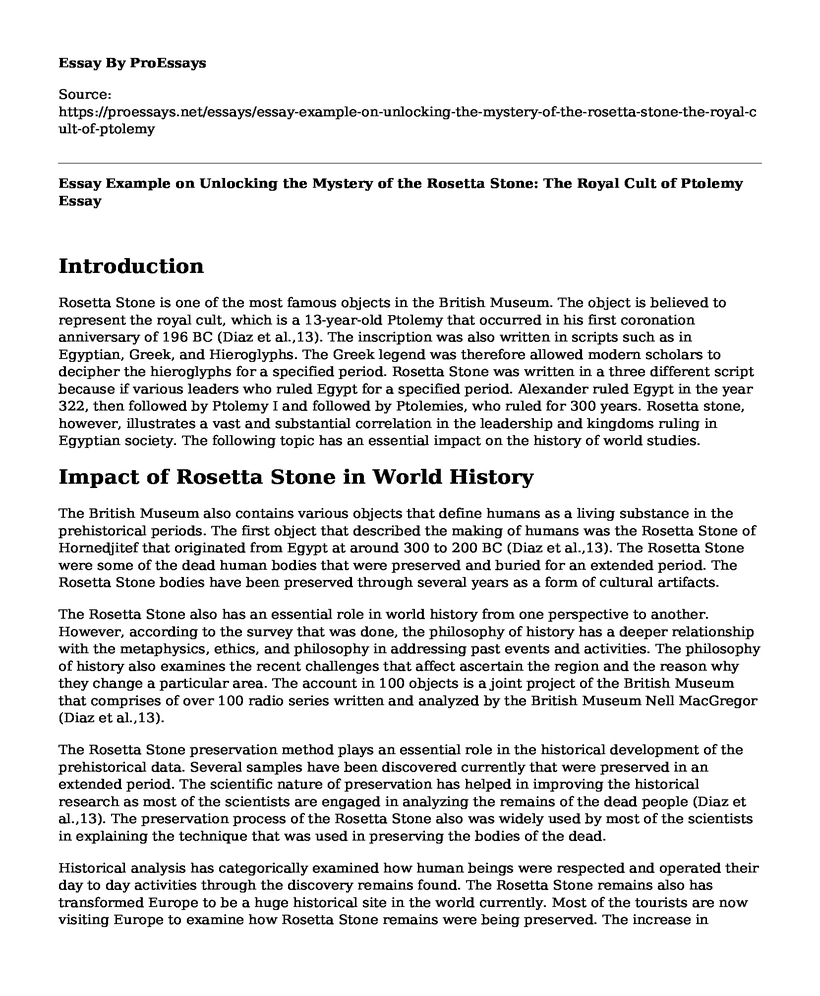Introduction
Rosetta Stone is one of the most famous objects in the British Museum. The object is believed to represent the royal cult, which is a 13-year-old Ptolemy that occurred in his first coronation anniversary of 196 BC (Diaz et al.,13). The inscription was also written in scripts such as in Egyptian, Greek, and Hieroglyphs. The Greek legend was therefore allowed modern scholars to decipher the hieroglyphs for a specified period. Rosetta Stone was written in a three different script because if various leaders who ruled Egypt for a specified period. Alexander ruled Egypt in the year 322, then followed by Ptolemy I and followed by Ptolemies, who ruled for 300 years. Rosetta stone, however, illustrates a vast and substantial correlation in the leadership and kingdoms ruling in Egyptian society. The following topic has an essential impact on the history of world studies.
Impact of Rosetta Stone in World History
The British Museum also contains various objects that define humans as a living substance in the prehistorical periods. The first object that described the making of humans was the Rosetta Stone of Hornedjitef that originated from Egypt at around 300 to 200 BC (Diaz et al.,13). The Rosetta Stone were some of the dead human bodies that were preserved and buried for an extended period. The Rosetta Stone bodies have been preserved through several years as a form of cultural artifacts.
The Rosetta Stone also has an essential role in world history from one perspective to another. However, according to the survey that was done, the philosophy of history has a deeper relationship with the metaphysics, ethics, and philosophy in addressing past events and activities. The philosophy of history also examines the recent challenges that affect ascertain the region and the reason why they change a particular area. The account in 100 objects is a joint project of the British Museum that comprises of over 100 radio series written and analyzed by the British Museum Nell MacGregor (Diaz et al.,13).
The Rosetta Stone preservation method plays an essential role in the historical development of the prehistorical data. Several samples have been discovered currently that were preserved in an extended period. The scientific nature of preservation has helped in improving the historical research as most of the scientists are engaged in analyzing the remains of the dead people (Diaz et al.,13). The preservation process of the Rosetta Stone also was widely used by most of the scientists in explaining the technique that was used in preserving the bodies of the dead.
Historical analysis has categorically examined how human beings were respected and operated their day to day activities through the discovery remains found. The Rosetta Stone remains also has transformed Europe to be a huge historical site in the world currently. Most of the tourists are now visiting Europe to examine how Rosetta Stone remains were being preserved. The increase in visitors in Europe has dramatically improved the economic structure in the market. Most prehistorical sites are currently preserving their remains using the Rosetta Stone preservation technique that was used by Europeans. The Rosetta Stone were some of the dead human bodies that were preserved and buried for an extended period. The Rosetta Stone remains have been preserved through several years as a form of cultural artifacts. Europe is one of the countries that practice this method for a more extended period.
Conclusion
Rosetta Stone's historical site plays an essential role in world history perspectives currently. There has been tremendous growth in the past activities that have been introduced through the use of the Rosetta Stone preservation technique. The British Museum also contains various objects that define humans as a living substance in the prehistorical periods. The first object that described the making of humans was the Hornedjitef that originated from the British.
Works Cited
Diaz, Sandra, et al. "A Rosetta Stone for Nature's Benefits to People." PLoS Biology 13.1 (2015).Accessed www.ncbi.nlm.nih.gov/pmc/articles/PMC4293102/
https://www.bbc.co.uk/programmers/b00sbrz3
Cite this page
Essay Example on Unlocking the Mystery of the Rosetta Stone: The Royal Cult of Ptolemy. (2023, May 23). Retrieved from https://proessays.net/essays/essay-example-on-unlocking-the-mystery-of-the-rosetta-stone-the-royal-cult-of-ptolemy
If you are the original author of this essay and no longer wish to have it published on the ProEssays website, please click below to request its removal:
- Why Being Bilingual Makes the Brain Stronger Essay
- What Can We Learn From Other Countries: Children and Families Paper Example
- An Exploration of Educators' Perspectives on Inclusion of Students With Disabilities in Catholic Schools
- Paper Example on Gentrification & Its Impact on US Neighborhoods
- Essay Sample on Evaluating Effects of State Takeover on Teachers & Students
- Essay Example on the Power of College Traditions: Building Shared Values & Identity
- Free Essay Example on Childhood vs. Adulthood: Cognitive & Social Development







